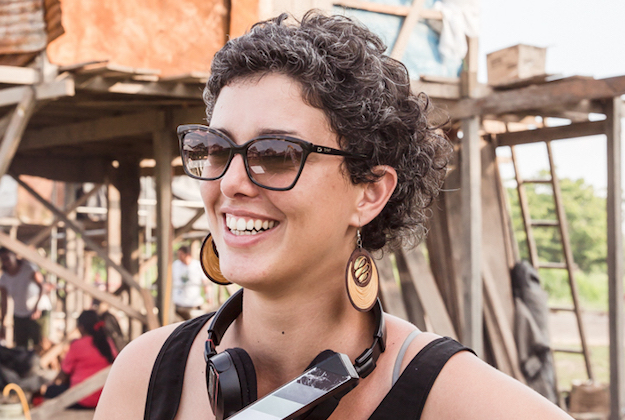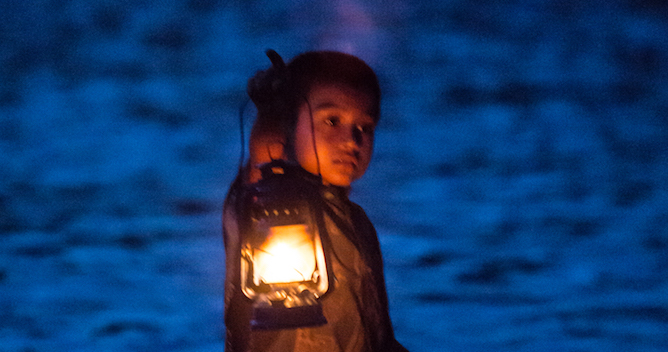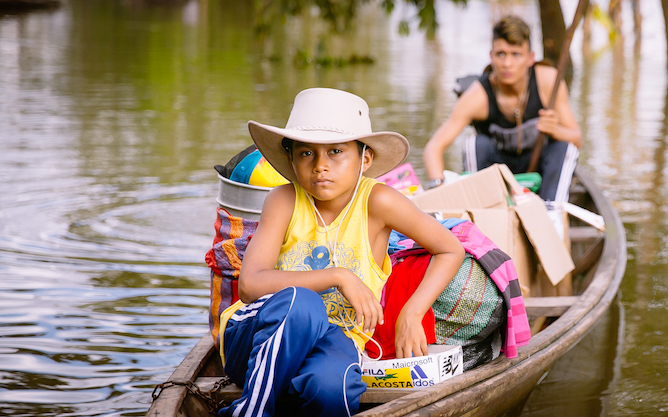In the opening scene of Beatriz Seigner’s Los Silencios, a longboat lunges in and out of the darkness, lurching through a river toward a light on the shore. After landing, figures emerge from the boat slowly, most noticeable among them a small girl in brightly colored earrings. They are part of the flood of refugees fleeing a half-century of guerilla bloodshed in Colombia’s mountains, and their destination is a wild, half-flooded island on the border between three Latin American nations. Seigner’s film focuses on a mother and her two young children who seek shelter in this coastal shantytown after their father has disappeared. With disquietingly hushed sound design and a steady, static camera held at a distance from its subjects, Seigner’s approach here and later is one of calm rather than chaos. This is the quiet left in the wake of the terror. But there is an eerie quality to the often nocturnal comings and goings of her characters: they exist on the margins in every sense, literal and metaphysical. The family’s day-to-day struggle to find work and settle into the uncertainty of their new lives forms the film’s loose narrative. Combining well-laid supernatural elements and poignant realism, Los Silencios was a highlight at the Directors’ Fortnight this year at Cannes and joins the successive waves of young Brazilian filmmakers reckoning with political realities though variations in augmented realism. Seigner’s second film (after 2010’s Bollywood Dream, the first ever Brazilian-Indian co-production) followed a considerable struggle with financing, pulling together a production budget from Colombian, French, and Brazilian sources. In the wake of a regime change in Brazil and a clampdown on public funds—not to mention the abolition of the national culture ministry—the filmmaker finds it difficult to imagine her film finding the capital to be made now. I spoke to her about Los Silencios a couple of weeks after its world premiere in Cannes.
How did you conceive of this family’s story and what brought you to the setting? When I first started writing, the story was actually going to take place in Brazil, with this family living in Manaus. But then I was looking for locations and I found this island on the border between Brazil, Colombia, and Peru, and I started to talk to the inhabitants. And I felt the film was there—I couldn’t imagine it anywhere else. It just fits perfectly the mood we wanted, because the island is underwater four months of the year and eight months above—so the island exists between two worlds. And of course our story is about someone who also exists between two worlds—the world of the living and the world of the dead. The immigration process is kind of a nowhere place too. I rewrote the script after I found this place, just to have the people from there in it. I love the fact that it’s an island that emerged from the river 20 years ago. They say that they don’t belong to any country, because no country wants to put electricity there, or collect trash, or help them in any way. How many actors in the film are actually inhabitants of the island? The only professional actors are the mother, Marleyda Soto, who is an amazing Colombian actress, and the father, Enrique Diaz, one of the best Brazilian actors of our time. They were the only professional actors who got the script, but I asked them not to memorize anything, because I wanted to improvise through rehearsal and get the most natural interactions possible, with the kids and with the people from the island. They were very open to this process. The rest are nonprofessional actors. The grandmother, Abuelita, is a Brazilian indigenous who lives on the island. Fabio [the young son in the family] is an immigrant from Peru. Everybody else from the island played themselves, and didn’t memorize any dialogue. I just wrote the scenes knowing the things they were going through, and asked them to do their encounters normally. With the last scene, at the death assembly [a meeting held so the living can consult with the dead], I cast people who were real victims of the war in Colombia. So we had a guerilla guy who was in the FARC for 15 years, and spent 20 years in jail. We had a guy from the paramilitary, a mother of a guerilla guy, people who were just victims of the war. I believe it was the first time that they actually heard the opposite side telling their story. We were all crying. They were just opening their hearts and it was very powerful. What was the editing process like when you were dealing with such emotional scenes? It was a long process. It took us six months to edit the film, and those assemblies were the most difficult. With the [death assembly] scene, we rolled for five to seven hours. Because our strategy was to put the camera in the center, we didn’t want it to be mechanical. We tried to film in a documentary style, and to capture naturally when they were speaking. So we put a camera in the center of the circle. I couldn’t say, “OK, enough, next one.” And we could not judge any of them, because probably if we were born in the same situation, we would have been involved in the same things. It’s a matter of circumstances, sometimes. A guy from the FARC said he joined the movement when he was 12 years old because out of his eight brothers, three were dead from hunger. And he saw his village having to move from one place to another, and he saw all this misery. So he felt it was a way to actually change things, to get education, to make a better way of life and system for his community. For the first cut of this assembly, I always knew the conflict was the context of our film but the story was the story of this mother and her kids, who has to deal with her ghosts somehow. And to find a way to keep living and loving, even though she has lost the most beloved people in her life. I don’t even know how people get through that. For me, it was this process of investigation, and when we were editing that scene, it was also very intuitive. The first cut was like 20 minutes, but we couldn’t have a 20-minute scene, so we just tried to get to the core. There are a lot of things I wish could have been in there, because some of the stories are so incredible. I do a lot of research before writing the script, so I interviewed about 80 families from Colombia living in Brazil. And some of the stories are like a film in and of themselves. But it’s an instinctive way of feeling what is stronger—it’s hard to explain rationally. We have a feeling like, “OK, let’s talk about forgiveness.”
Can you tell me a bit about the style of the film? Your camera is very static, and its placement is very distant and unobtrusive. You allow your characters to move in and out of the frame. There were two major things in the direction of the photography and the art direction that I was sure I wanted. One was to have spaces that were really black, where you can’t see anything, and to have characters coming out of those places—because we are talking about things we can’t see and don’t have answers for. For those scenes, I worked with the sound design to have steps, or the movement of the wood in the house, or ambient distorted nature sounds, create an atmosphere. And I didn’t want the camera to travel a lot. I don’t like it much when movies do that. I feel manipulated. I like when the emotion comes by itself, not because I’m doing it through slow motion or music. I’m already seeing the mother is touched, for example, when she is receiving the letter. I can already see she’s collapsing there. The more emotional the scene, the farther away I feel like being with the camera. Just out of respect. I think the more emotional it is, the further away I want to be, so the person can be in that moment. A real close-up is unnecessary. Your use of neon colors and the way they trickle into the film slowly is striking—beginning with tiny details or accessories and eventually drenching the film, painted elaborately on people’s faces, and so on. Is there a cultural significance to those colors? I’m interested in talking a bit more about how the people on the island commune with the dead and the dead interject themselves into the lives of their loved ones. And it’s very ordinary to them. Can you tell me a bit more about the way they perceive grief? In some parts of Colombia, they believe that if you don’t find the body of someone who has disappeared, you have to keep the things from their personal life. You still put their food on the table, you still keep their clothes and everything waiting in the hope this person is still alive. This is particularly in Colombia, I haven’t heard of this in Brazil. But in Brazil, maybe because of our indigenous and African ancestry, there are places where you can talk with the dead and ask advice. They even talk about politics. Everybody goes, it’s not something that’s seen as surreal. People bless their houses with herbs, and once a year we have a shower with salt to get bad spirits away. We are a mystical country. A person can be Catholic or from any religion, but they still keep these indigenous rituals. It’s in their daily life.
The female experience is at the forefront of this film. What I took away was this sense of how often women are left to hold their families together and to pick up the pieces in these situations. It’s very common in Latin America to have families without fathers, where the women are taking care of everything. So this presence that is a ghost can also be a metaphor in that way. I also want to show the dignity of this woman. I didn’t want to show pity. She’s in a humble position, but she’s going to fight for whatever she needs to feed her kids and put them in school. Maybe she won’t be able to do as much as she wants, because she doesn’t have support from anyone. But they also need more support, from the government, from the community. Also, in the process of writing the script, I had a son. After I gave birth, I rewrote the script because I felt that the mother character needed to be stronger. And on our set, we actually had three women breastfeeding. Almost all our crew are women—the DP, the art department, the editor, and of course me. So I was one of the women breastfeeding on set. That’s the future of film sets! Can you talk to me a little bit about your production company and that desire to be autonomous, have final cut, and so on? It’s really a small company. It’s me and my partner Ibira Machado, and we can apply for Brazilian public funding. It means having the autonomy to shoot in the way I believe, to have equal salaries and share the budget in a way I believe is fair. There’s more transparency with the crew. So it’s very artisanal. But I don’t know how much longer we’ll be able to do that, because we’ve had a coup d’état in Brazil, and the new minister of culture is trying to close the funding for artistic films. They just want to invest in Brazilian blockbusters or have Americans go in and shoot their big blockbusters in Brazil. So there’s a change of direction in the Brazilian cultural life, because right now we have films at big festivals and are being recognized worldwide, but the new minister of culture doesn’t care about that. Also, many of us are left-wing, and they’re not happy because we’re saying it was a coup d’état. For example, Kleber Mendonça Filho did this protest in Cannes in 2016, when he was in the competition [with Aquarius]. Now they are opening all the accounts of the film, and trying to say he was given more money than he was meant to have, which is clearly political persecution. So there may be persecution for any filmmaker who speaks out about what is happening in Brazil. Maybe I’ll have to finance my next film overseas. Christina Newland is a writer on film, culture, and boxing, with bylines at Sight & Sound, The Guardian, Little White Lies, Hazlitt, and others.


